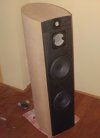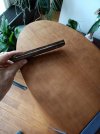@JanRSmit I think S.L. answers those questions very well in those links.
I was mostly thinking about radiation pattern, and thus how room resonances affect the sound, but of course there are some benefits of not having to deal with box resonances in itself, and the reflected sound from inside the cabinet out through the cone.
Kvalsvoll, and Youngho, thanks for the response. Kvallvoll your info in this thread is about speaker-room interaction (and follow with great interest) , that is why i asked.
Yes i am aware of Linkwitz findings. I can also understand that the shape of the entire box has an influence in that interaction.
Regarding the box itself i am using short-fibre very well cleansed wool 'blobs' to fill the cavity, for 2 reasons: damping of the fundamental resonance of the driver, and damping of cavity resonances. This has proven to be a quite effective solution. When professionally active in loudspeaker production(many many years ago), we did a lot of testing and f.i. a test by placing a sheet of BAF (Bonded Acetate Fibre) in the cavity of a midrange (Thiel C2-77) together with wool and it sounded very "active" (very eufemistic statement ;-) ). The cavity resonances were indeed coming back via the driver and sounded awful. Removing the BAF layer completely removed this 'activeness'. Similar "active" effect happens if you card the wool by the way. We learned that the way the wool filling in the cavity was constructed is quite crucial.
The damping at low frequencies (this midrange resonance was ~ 100 Hz) is the result of the fibres reacting to pressure variations. The fibre structure resembles a pine-cone, and the 'petals' open or close under pressure variations, thus absorbing energy.
As Linkwitz states in one of his many publications, the box structure itself needs to be well damped as well. My current loudspeakers are constructed such that structural resonances and sound transmission is minimalized. The cross-section is an ellips truncated by the baffle, the wall material used is composed of thin (~1.5mm) layers of HPL (the brown core material of formica) glued with epoxy glue, and in the middle a damping layer (Constrained Layer Damping) specific for thick stiff structures (engine support structure and hull for GRP made yachts etc). The bulkheads separating the bass driver's cavities are also thick HPL plates. The part where the midrange and tweeter are is composed of layers of MDF with irregular shaped cavities for mid and tweeter, the total stack being some 30cm high. The baffle plate is also composed of two thick HPL layers with a CLD damping layer in between.
All in all the loudspeaker-box is quite dead both structurally and cavity wise. Also, given its high rigidity coupled with some serious mass (> 70kilo) it forms a excellent 'launching' platform for cone movements (action=reaction), which is also important.


